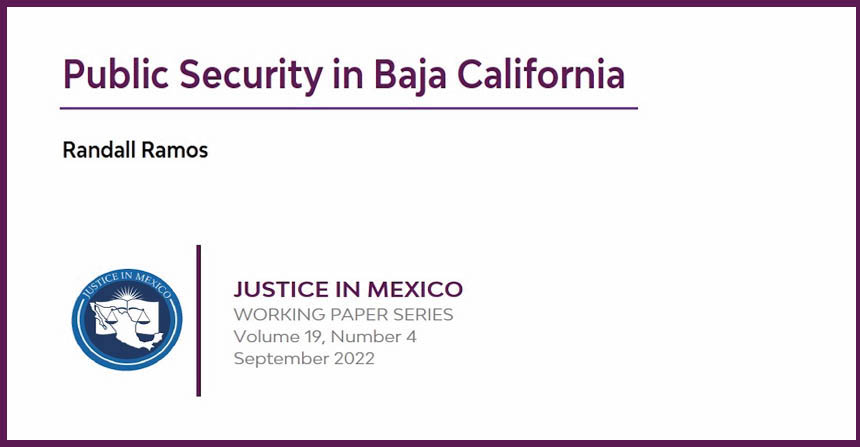 03/25/14 — University of San Diego’s Justice in Mexico Project and the Woodrow Wilson Center’s Mexico Institute are pleased to announce the publication of “Building Resilient Communities in Mexico: Civic Responses to Crime and Violence,” now available in print and online. The book offers concrete policy options for government leaders in Mexico and the United States to build on current civic engagement efforts to strengthen the rule of law and improve security in Mexico. The book examines ways to enhance civic responses to violence in Mexico, increase civic engagement with the state in promoting the rule of law, and help to shape public debate on the issue more broadly. In light of recent concerns about the desperate measures taken by vigilantes and armed self-defense groups in rural Mexico, this new book provides a timely effort to evaluate the constructive responses of Mexican society in the face of years of crime and violence, bringing together experts from the United States and Mexico to consider a variety of related issues. “This work is important because it helps paint a more complete picture of responses to organized crime in Mexico. Civil society plays a critical role in guaranteeing buy-in from the community and it’s important that these perspectives be included in the broader policy discussion,” said David Shirk, JMP director and Mexico Institute Global Fellow. “It is increasingly clear that the long-term solution to Mexico’s public security dilemmas lies in a closer and more dynamic interaction between public authorities and the communities afflicted by crime and violence. This book seeks to identify best practices and sound principles to guide such interaction,” said Duncan Wood, director of the Mexico Institute. The book is comprised of three sections. The first examines the roots of violence and civil society’s responses, while the second section focuses on communities targeted by violence and their mobilization efforts in response. The book concludes with a section devoted to engaging and strengthening judicial sector institutions. In section one, Matthew C. Ingram begins with his chapter, “Community Resilience to Violence: Local Schools, Regional Economies, and Homicide in Mexico’s Municipalities,” that focuses on community resilience and its current emphasis in the Merida Initiative’s effort to reduce violence. Ingram incorporates measures of this concept in a sub-national analysis of 2010 homicide rates across Mexico’s 2,455 municipalities. In Steven Dudley and Sandra Rodríguez Nieto’s chapter, “Civil Society, the Government, and the Development of Citizen Security,” the authors discuss how civil society organizations have interacted with government authorities and security forces in four Mexican cities where violence and organized crime have been on the rise: Ciudad Juárez, Monterrey, Nuevo Laredo, and Tijuana. The section’s last chapter, “Understanding and Addressing Youth ‘Gangs’ in Mexico” by Nathan P. Jones, analyzes how the security-centric lens on ‘gangs’ only exacerbates youth involvement in gangs, while ‘social integration’ and/or human rights approaches are more effective and less costly. In section two, in “The Victims’ Movement in Mexico,” Lauren Villagran examines how civic engagement and its potential contribution to a culture of lawfulness and security in Mexico are incipient and highly vulnerable to internal fissures and difficulties in dealing with authorities. Emily Edmonds-Poli then focuses her chapter, “The Effects of Drug-War Related Violence on Mexico’s Press and Democracy,” on the causes and consequences of violence against journalists, and evaluates the response by Mexico’s government and society. Lucy Conger concludes the section with her analysis of the role of the private sector—including industry, commerce, and civil society—in responding to sharp increases of violence in Ciudad Juárez and Monterrey in her chapter, “The Private Sector and Public Security: The Cases of Ciudad Juárez and Monterrey.” Finally, the concluding section features contributions from Octavio Rodríguez and Daniel M. Sabet. Rodríguez begins with “Civic Engagement and the Judicial Reform: The Role of Civil Society in Reforming Criminal Justice in Mexico,” which looks at the role played by organized civil society in the judicial reform process, highlighting the efforts of certain organizations that became particularly influential and emblematic of civic activism in the area of criminal justice reform. Sabet concludes with an analysis of how citizens can help respond to Mexico’s security challenges, specifically recommending greater collaboration between civilians and police, and a greater role in civilian oversight of public officials and law enforcement agencies. “Building Resilient Communities in Mexico” was edited by JMP Director David A. Shirk, Mexico Institute Director Duncan Wood, and Associate Director of WWC’s Latin American Program Eric Olson. Read the full-version of the publication here. Follow the book’s launching and public presentations at the University of San Diego on March 25 from 2:30-4:00pm (PST), at the Mexico Institute on March 27 from 2:30-4:00pm (EST), and on Facebook and Twitter at #PillarIV, @JusticeinMexico, and @MexicoInstitute.
03/25/14 — University of San Diego’s Justice in Mexico Project and the Woodrow Wilson Center’s Mexico Institute are pleased to announce the publication of “Building Resilient Communities in Mexico: Civic Responses to Crime and Violence,” now available in print and online. The book offers concrete policy options for government leaders in Mexico and the United States to build on current civic engagement efforts to strengthen the rule of law and improve security in Mexico. The book examines ways to enhance civic responses to violence in Mexico, increase civic engagement with the state in promoting the rule of law, and help to shape public debate on the issue more broadly. In light of recent concerns about the desperate measures taken by vigilantes and armed self-defense groups in rural Mexico, this new book provides a timely effort to evaluate the constructive responses of Mexican society in the face of years of crime and violence, bringing together experts from the United States and Mexico to consider a variety of related issues. “This work is important because it helps paint a more complete picture of responses to organized crime in Mexico. Civil society plays a critical role in guaranteeing buy-in from the community and it’s important that these perspectives be included in the broader policy discussion,” said David Shirk, JMP director and Mexico Institute Global Fellow. “It is increasingly clear that the long-term solution to Mexico’s public security dilemmas lies in a closer and more dynamic interaction between public authorities and the communities afflicted by crime and violence. This book seeks to identify best practices and sound principles to guide such interaction,” said Duncan Wood, director of the Mexico Institute. The book is comprised of three sections. The first examines the roots of violence and civil society’s responses, while the second section focuses on communities targeted by violence and their mobilization efforts in response. The book concludes with a section devoted to engaging and strengthening judicial sector institutions. In section one, Matthew C. Ingram begins with his chapter, “Community Resilience to Violence: Local Schools, Regional Economies, and Homicide in Mexico’s Municipalities,” that focuses on community resilience and its current emphasis in the Merida Initiative’s effort to reduce violence. Ingram incorporates measures of this concept in a sub-national analysis of 2010 homicide rates across Mexico’s 2,455 municipalities. In Steven Dudley and Sandra Rodríguez Nieto’s chapter, “Civil Society, the Government, and the Development of Citizen Security,” the authors discuss how civil society organizations have interacted with government authorities and security forces in four Mexican cities where violence and organized crime have been on the rise: Ciudad Juárez, Monterrey, Nuevo Laredo, and Tijuana. The section’s last chapter, “Understanding and Addressing Youth ‘Gangs’ in Mexico” by Nathan P. Jones, analyzes how the security-centric lens on ‘gangs’ only exacerbates youth involvement in gangs, while ‘social integration’ and/or human rights approaches are more effective and less costly. In section two, in “The Victims’ Movement in Mexico,” Lauren Villagran examines how civic engagement and its potential contribution to a culture of lawfulness and security in Mexico are incipient and highly vulnerable to internal fissures and difficulties in dealing with authorities. Emily Edmonds-Poli then focuses her chapter, “The Effects of Drug-War Related Violence on Mexico’s Press and Democracy,” on the causes and consequences of violence against journalists, and evaluates the response by Mexico’s government and society. Lucy Conger concludes the section with her analysis of the role of the private sector—including industry, commerce, and civil society—in responding to sharp increases of violence in Ciudad Juárez and Monterrey in her chapter, “The Private Sector and Public Security: The Cases of Ciudad Juárez and Monterrey.” Finally, the concluding section features contributions from Octavio Rodríguez and Daniel M. Sabet. Rodríguez begins with “Civic Engagement and the Judicial Reform: The Role of Civil Society in Reforming Criminal Justice in Mexico,” which looks at the role played by organized civil society in the judicial reform process, highlighting the efforts of certain organizations that became particularly influential and emblematic of civic activism in the area of criminal justice reform. Sabet concludes with an analysis of how citizens can help respond to Mexico’s security challenges, specifically recommending greater collaboration between civilians and police, and a greater role in civilian oversight of public officials and law enforcement agencies. “Building Resilient Communities in Mexico” was edited by JMP Director David A. Shirk, Mexico Institute Director Duncan Wood, and Associate Director of WWC’s Latin American Program Eric Olson. Read the full-version of the publication here. Follow the book’s launching and public presentations at the University of San Diego on March 25 from 2:30-4:00pm (PST), at the Mexico Institute on March 27 from 2:30-4:00pm (EST), and on Facebook and Twitter at #PillarIV, @JusticeinMexico, and @MexicoInstitute.
—————————-
Based at the University of San Diego, the Justice in Mexico Project promotes analysis, dialogue, and policy solutions to address a variety of urgent problems related to security and violence, transparency and accountability, and justice and human right issues in Mexico and the U.S.-Mexico border region.
The Woodrow Wilson International Center for Scholars is the national, living memorial honoring President Woodrow Wilson. The Wilson Center provides a strictly nonpartisan space for the worlds of policymaking and scholarship to interact. By conducting relevant and timely research and promoting dialogue from all perspectives, it works to address the critical current and emerging challenges confronting the United States and the world. Created by an Act of Congress in 1968, The Wilson Center is headquartered in Washington, D.C. and supported by both public and private funds.




